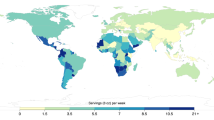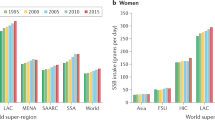Abstract
Background/Objectives:
Replacing added sugars in beverages and foods with low-calorie sweeteners (LCSs) is one strategy to reduce calories and manage body weight. There are few studies on LCS consumption by product category and by consumer socio-demographic status.
Subjects/Methods:
Data for a representative sample of 22 231 adults were obtained from five cycles of the National Health and Nutrition Examination Survey (1999–2008 NHANES). A single 24-h recall was used to identify consumers of LCS beverages, foods and tabletop sweeteners. Time-trend analyses were conducted for total LCS consumption and for LCS beverages.
Results:
Approximately 30% of US adults consumed some type of LCS, with 19.5% consuming LCS beverages, 11.4% consuming tabletop LCS and 4.6% consuming LCS foods. LCS consumption by product category peaked at different ages, with older adults more likely to consume tabletop LCS and LCS foods. In age-adjusted analyses, LCS consumers in every product category were more likely to be women, 45–65 years old, non-Hispanic whites, US-born adults, college graduates and with higher household incomes. Predictors of LCS consumption were not altered upon adjustment for body mass index and diabetes status. LCS consumption from all sources and from LCS beverages increased between 1999 and 2008.
Conclusions:
LCS use was more common among populations with a lower burden of obesity and related chronic disease, specifically, non-Hispanic whites and those with more education/higher incomes. The reasons for this observed paradox are complex and merit additional research.
This is a preview of subscription content, access via your institution
Access options
Subscribe to this journal
Receive 12 print issues and online access
$259.00 per year
only $21.58 per issue
Buy this article
- Purchase on Springer Link
- Instant access to full article PDF
Prices may be subject to local taxes which are calculated during checkout




Similar content being viewed by others
References
Schulze MB, Manson JE, Ludwig DS, Colditz GA, Stampfer MJ, Willett WC et al. Sugar-sweetened beverages, weight gain, and incidence of type 2 diabetes in young and middle-aged women. JAMA 2004; 292: 927–934.
de Koning L, Malik VS, Kellogg MD, Rimm EB, Willett WC, Hu FB . Sweetened beverage consumption, incident coronary heart disease, and biomarkers of risk in men. Circulation 2012; 125: 1735–1741. S1.
Fung TT, Malik V, Rexrode KM, Manson JE, Willett WC, Hu FB . Sweetened beverage consumption and risk of coronary heart disease in women. Am J Clin Nutr 2009; 89: 1037–1042.
Johnson RK, Appel LJ, Brands M, Howard BV, Lefevre M, Lustig RH et al. Dietary sugars intake and cardiovascular health: a scientific statement from the American Heart Association. Circulation 2009; 120: 1011–1020.
Yang Q, Zhang Z, Gregg EW, Flanders WD, Merritt R, Hu FB . Added sugar intake and cardiovascular diseases mortality among US adults. JAMA Int Med 2014; 174: 516–524.
Gardner C, Wylie-Rosett J, Gidding SS, Steffen LM, Johnson RK, Reader D et al. Nonnutritive sweeteners: current use and health perspectives: a scientific statement from the American Heart Association and the American Diabetes Association. Diabetes Care 2012; 35: 1798–1808.
Anderson GH, Foreyt J, Sigman-Grant M, Allison DB . The use of low-calorie sweeteners by adults: impact on weight management. J Nutr 2012; 142: 1163S–1169S.
Mattes RD, Popkin BM . Nonnutritive sweetener consumption in humans: effects on appetite and food intake and their putative mechanisms. Am J Clin Nutr 2009; 89: 1–14.
Phelan S, Lang W, Jordan D, Wing RR . Use of artificial sweeteners and fat-modified foods in weight loss maintainers and always-normal weight individuals. Int J Obes (Lond) 2009; 33: 1183–1190.
Piernas C, Ng SW, Popkin B . Trends in purchases and intake of foods and beverages containing caloric and low-calorie sweeteners over the last decade in the United States. Pediatr Obes 2013; 8: 294–306.
Sylvetsky AC, Welsh JA, Brown RJ, Vos MB . Low-calorie sweetener consumption is increasing in the United States. Am J Clin Nutr 2012; 96: 640–646.
Welsh JA, Sharma AJ, Grellinger L, Vos MB . Consumption of added sugars is decreasing in the United States. Am J Clin Nutr 2011; 94: 726–734.
Monsivais P, Aggarwal A, Drewnowski A . Are socio-economic disparities in diet quality explained by diet cost? J Epidemiol Community Health 2012; 66: 530–535.
Drewnowski A, Rehm CD . Energy intakes of US children and adults by food purchase location and by specific food source. Nutr J 2013; 12: 59.
Maillot M, Vieux F, Amiot MJ, Darmon N . Individual diet modeling translates nutrient recommendations into realistic and individual-specific food choices. Am J Clin Nutr 2010; 91: 421–430.
Centers for Disease Control and Prevention About the National Health and Nutrition Exmaination Survey. Available at http://www.cdc.gov/nchs/nhanes/about_nhanes.htm Accessed on 1 November 2014.
Centers for Diseae Control and Prevention. NCHS Research Ethics Review Board (ERB) Approval http://www.cdc.gov/nchs/nhanes/irba98.htm Accessed on 5 November 2014.
Centers for Disease Control and Prevention National Center for Health Statistics. National Health and Nutrition Examination Survey. In. Hyattsville, MD: U.S. Department of Health and Human Services, Center for Disease Control and Prevention. Available from http://www.cdc.gov/nchs/tutorials/dietary/SurveyOrientation/DietaryDataOverview/Info2.htm.
Ahuja JK, Montville JB, Omolewa-Tomobi G, Heendeniya KY, Martin CL, Steinfeldt LC et al. USDA Food and Nutrient Database for Dietary Studies, 5.0. In. U.S. Department of Agriculture, Agricultural Research Service. Food Surveys Research Group: Beltsville, MD, 2012.
Ogden CL, Carroll MD, Kit BK, Flegal KM . Prevalence of obesity in the United States, 2009-2010. NCHS Data Brief 2012; 1–8.
Centers for Disease Control and Prevention. Crude and Age-Adjusted Rate per 100 of Civilian, Noninstitutionalized Adults with Diagnosed Diabetes, United States, 1980–2011. Available at http://www.cdc.gov/diabetes/statistics/prev/national/figageadult.htm Accessed on 20 November 2014.
Stringhini S, Sabia S, Shipley M, Brunner E, Nabi H, Kivimaki M et al. Association of socioeconomic position with health behaviors and mortality. JAMA 2010; 303: 1159–1166.
Lo YT, Chang YH, Lee MS, Wahlqvist ML . Health and nutrition economics: diet costs are associated with diet quality. Asia Pac J Clini Nutr 2009; 18: 598–604.
Serdula MK, Mokdad AH, Williamson DF, Galuska DA, Mendlein JM, Heath GW . Prevalence of attempting weight loss and strategies for controlling weight. JAMA 1999; 282: 1353–1358.
Block JP, Gillman MW, Linakis SK, Goldman RE . "If it tastes good, I'm drinking it": qualitative study of beverage consumption among college students. J Adolesc Health 2013; 52: 702–706.
Drewnowski A, Rehm CD, Constant F . Water and beverage consumption among adults in the United States: cross-sectional study using data from NHANES 2005-2010. BMC Public Health 2013; 13: 1068.
Acknowledgements
Analyses of the publicly available NHANES database were supported by the Calorie Control Council.
Author information
Authors and Affiliations
Corresponding author
Ethics declarations
Competing interests
AD has received grants, honoraria and consulting fees from numerous food, beverage and ingredient companies and other commercial and nonprofit entities with an interest in sweeteners, obesity and diet quality issues. CDR has no conflicts to report.
Rights and permissions
About this article
Cite this article
Drewnowski, A., Rehm, C. Socio-demographic correlates and trends in low-calorie sweetener use among adults in the United States from 1999 to 2008. Eur J Clin Nutr 69, 1035–1041 (2015). https://doi.org/10.1038/ejcn.2015.38
Received:
Revised:
Accepted:
Published:
Issue Date:
DOI: https://doi.org/10.1038/ejcn.2015.38
This article is cited by
-
The consumption of low-calorie sweetener containing foods during pregnancy: results from the ROLO study
European Journal of Clinical Nutrition (2022)
-
Long-term trends in the consumption of sugary and diet soft drinks among adolescents: a cross-national survey in 21 European countries
European Journal of Nutrition (2022)
-
Assessment of artificial and natural sweeteners present in packaged non-alcoholic beverages (NABs) sold on the Singapore market
BMC Public Health (2021)
-
Consumption of non-nutritive sweeteners by pre-schoolers of the food and environment Chilean cohort (FECHIC) before the implementation of the Chilean food labelling and advertising law
Nutrition Journal (2020)
-
Consumption of sugar-sweetened beverages and artificially sweetened beverages from childhood to adulthood in relation to socioeconomic status – 15 years follow-up in Norway
International Journal of Behavioral Nutrition and Physical Activity (2018)



